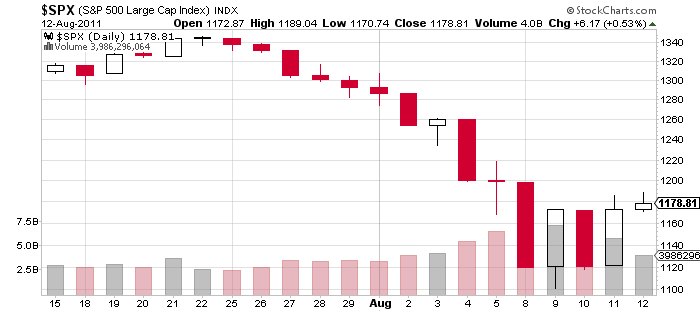Last week’s S&P 500 chart is unusual. After Monday’s massive 80-point
drop, the S&P 500 bounced in a huge range between 1,120 and 1,180.
Volume was very heavy.

As we discussed over the last few days, the extreme volatility has been the
result of a virtual perfect storm of uncertainty. The S&P downgrade,
the last minute debt deal in Congress, the potential for recession and an
escalation of debt issues in Europe.
The above chart also shows the S&P 500 was above 1,340 just a few weeks
ago. At last week’s lows, the S&P 500 was off around 17%. That’s a
sharp decline, no doubt.
To put the current levels of the S&P 500 in a little perspective, the
highs for 2010 were just above 1,250. And the highs for 2009 were around
1,150. So at 1,180, the S&P 500 is in the range that it’s been ever
since it recovered from the 2008-2009 crash.
But whether that level means value or not depends on earnings. According to
the Wall Street Journal, the S&P 500 is trading at 10.6 times projected
earnings. That’s cheap, no doubt about it. But of course, the reason it’s
cheap is that some investors do not believe earnings projections are
accurate.
Yes, corporations have been beating estimates for 2 years now. And there
are still skeptics. Eventually, they will be right, simply based on the
"broken clock" theory. But up to an including this earnings season,
expectations that earnings will miss projections have gone wanting.
As I continue to write: companies have adjusted their costs and production
to meet current demand. Count me squarely in the camp that believes
earnings growth can continue.
One way to measure value in the market is through acquisitions. When
companies believe other companies are attractively valued and can help them
grow, they buy them. That’s why this morning’s announcement that Google
(Nasdaq:GOOG) is buying Motorola Mobility (NYSE:MMI) is bullish.
Buying Motorola Mobility gives Google a handset and tablet manufacturer.
That means Google is now going directly after Apple market share. This will
be very interesting.
The stock market is doing its best to shrug off the recent correction. But
it’s tough to say that it’s all up from here. Corrections happen, and they
will happen again…
Approximately 70% of trading on the NYSE is computer based institutional
activity, we must understand that prices can be extremely volatile. I’m not
sure this is a situation that can be "fixed." But as investors, there are a
few things we can do to help ourselves sleep better when the stock market
corrects, as it inevitably will.
Number 1: own good stocks. It’s critical that we own stocks we can be
confident about. That doesn’t just mean blue chips. We can remain confident
about small caps, dividend stocks, ETFs, and other if we understand the
company completely.
Number 2: own some protection. Be it gold, an inverse ETF, put options, or
something else, it’s always a good idea to own some kind of protection for
your portfolio holdings. There are a number of ways to initiate protection.
You could add some assets that will rise as stocks fall when the market
makes brand new highs and may pull back, you could add as the market fails
to make new highs (as we saw recently), you could add protection on a
seasonal basis ("sell in May" has been reliable lately, as has a late-July
sell-off). Whatever timing mechanism you use, having downside protection
can help alleviate the stress and the losses of a correction.
Number 3: Don’t get fully invested. Keep some cash on hand to deploy when
the market corrects. There will often be great opportunities to add quality
during a correction. The key is to be patient and let it happen. Even in
the strongest bull market, stocks will correct.
It’s not always possible to pull off, but another way to manage a
correction is to sell quick. Whether you keep tight stop losses, or have a
quick trigger finger, you can exit riskier stocks quickly at the start of a
correction.
After consulting with the research analyst at Small Cap Investor PRO, Tyler
Laundon, we decided to employ this technique with one stock in the Small
Cap Investor PRO portfolio. We took a 16% profit off the table, and then
were able to re-enter the stock 21% lower than when we sold it. I expect
we’ll be back in the profit zone soon with this stock.
Selling early in a correction isn’t always the easiest thing to do, but it
can be effective.
Click
here to read more articles from the Daily Profit blog.
 Facebook
Facebook
 Twitter
Twitter